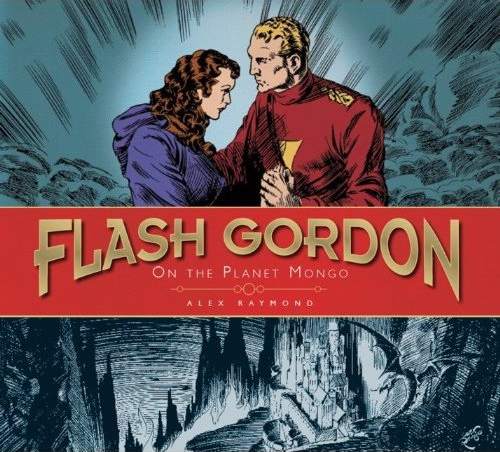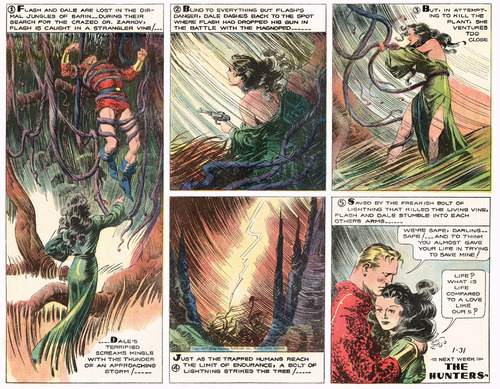The first volume of the new Flash Gordon collection is a colorful treat for fans of the form.

The world is coming to an end, as another planet is about to collide with Earth, and the only way to stop it is to hit it with a powerful rocket, otherwise all life on both planets will perish in a massive explosion.
Flash Gordon, “world-renowned polo player” and Dale Arden, an otherwise anonymous pretty girl, end up on this rocket, along with its designer and pilot Dr. Zarkov, in a case of mistaken identity. The plan works, and the worlds will no longer collide, but Flash, Dale and Zarkov are now stranded forever on the strange world of Mongo. That’s just the first page and a half, and the story gets more odd from there.
Starting in January of 1934, the original run of Flash Gordon was serialized in weekly newspapers until 1942. Flash Gordon on the Planet Mongo collects the first few years of that run. In these 200 weeks, Flash crosses through many territories of the strange planet, meeting various strange denizens of the world, becoming a political prisoner, a concubine, a soldier, a king, a prisoner again, then finally a sort of mercenary. Along the way, he falls in love with the pretty, but useless, girl who came with him from earth, having to rescue her from every monster imaginable, while more powerful and interesting women of Mongo throw themselves futilely at his affections.
The illustrations are beautiful in their wonderful primary colors, an artifact of the day’s printing practices, and looking at them is like walking through a lesson in comics art history, as one can see the clear influence that Alex Raymond’s illustrations have had on comics artists through to today. Lots of style elements established here, from the rapid, yet complex, shading styles to the mostly half-naked characters of both sexes – almost no one wears pants on Mongo – can be seen in the adventure and super hero comics that followed right after, and continue into the most recent tales.

The story itself feels trite often, though that’s really only by modern standards, and is partly due to this story having established some of the tropes we’ve come to recognize in adventure tales.
What’s bound to be unfamiliar to modern comics fans is the strange pacing. We’re used to a single scene taking several pages to depict, while Flash Gordon typically sees several scenes go by in one page, with some scenes only getting a single panel of illustration. Lots of action is glossed over in favor of dialogue-heavy moments.
The high-quality, hard-bound volume begins with an introduction from prolific and popular modern comics illustrator Alex Proyas, who gives us a lesson in comics illustration history, and who really knows his stuff. The article, The Flash Gordon Legacy, and the follow up, Birth of a Legend by Doug Murray, start us off with a good idea of how Flash Gordon fits into the comics industry, and into society as a whole, showing how the strip grew from what was essentially a commercial clone of Buck Rogers, into a famous franchise all its own. Ross and Murray both really know their stuff, and paint a compelling picture of the context in which Flash Gordon must be placed.
The volume is a great, entertaining history lesson for comics fans or artists, and for everyone else it’s a nostalgic look back at the comics that came before the ‘golden age’ of comics.
Flash Gordon: On the Planet Mongo is available now from Titan Books.






